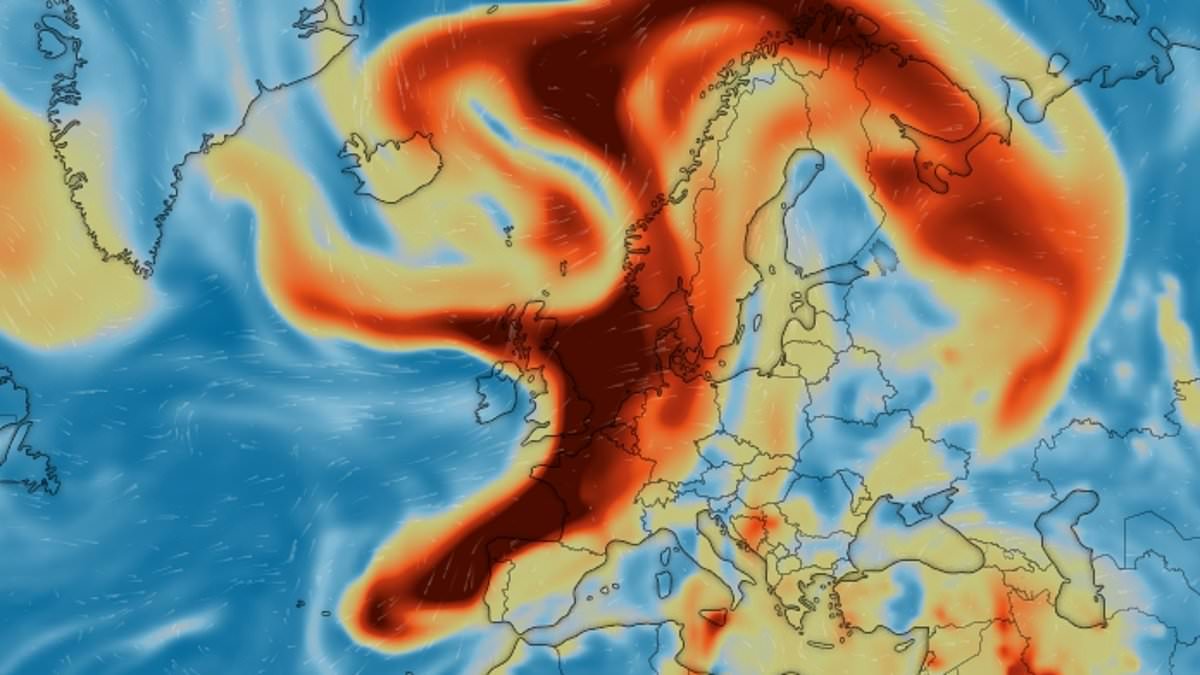Britain has this morning been engulfed with a huge cloud of sulphur dioxide spread from the volcanic eruption in Iceland, according to a weather map.
A huge cloud of SO2 completely covered the country by 4am with it still covering half of the UK at 8.45am, data by Czech weather portal Windy showed.
SO2 is predominantly produced from the combustion of coal or crude oil but volcanoes also produce huge quantities of it when they erupt.
Inhaling the gas can cause symptoms such as a sore throat, coughing, a runny nose, burning eyes, tight lungs and difficulty breathing.
The colourless gas has an irritating pungent odour (familiar as the smell of a just-struck match) and can also cause stinging pain, redness and blisters when it comes in contact with the skin.
Have YOU been affected? Email [email protected]
Prof Simon Carn, of Michigan Technological University, wrote on X: ‘Another batch of #volcanic SO₂ en route to the #UK / #Ireland, courtesy of the latest #eruption on #Iceland ‘s #Reykjanes peninsula. Might cause some local #AirQuality impacts in the coming days. @eddy_weather @ScottishEPA.’
Direct exposure to SO2 is associated with asthma and chronic bronchitis, with the SO2 emitted from coal burning during the London smog in 1952 playing a key role in the thousands of respiratory-related deaths at the time.
SO2 can also combine with water vapour in the earth’s atmosphere to form acid rain that can travel large distances.
Elderly people are particularly vulnerable to SO2 inhalation, while charity Asthma and Lung UK say more people with asthma are admitted to hospital with asthma attacks when there are high levels of the gas.
Young children may also be more sensitive to the effects of SO2 due to their smaller size, a government document reads.
In June, experts said a non-explosive fissure on the Reykjanes Peninsula in Iceland may have caused an ‘unprecedented’ spike in SO2 levels in Edinburgh not seen since the 1970s.
UK Centre for Ecology and Hydrology’s senior air pollution modeller, Dr Massimo Vieno, said there was likely to be ‘minimal’ damage to the environment, reported the BBC.
He said: ‘This was an extremely unusual event that happened for a very short period of time.
‘We basically had a large explosion in Iceland, which combined with exactly the right configuration of wind to bring the plume from the Reykjanes Peninsula to Scotland and to Edinburgh specifically.
‘It is a very unique event’.
The plumes of dangerous smog floated over from Iceland after a volcano in the Reykjanes Peninsula near Grindavik erupted on Thursday.
The eruption had been expected for a few weeks due to the ongoing seismic activity in the area and due to pressure changes in boreholes.
Reports said rescue teams had been called up in Reykjanes and Ölfus, as thousands of people in Grindavik and the Blue Lagoon had to be evacuated.
Local authorities told residents to stay away from the area for their own safety and for the safety of emergency services.
previously reported that Iceland had been rocked by eight volcanic eruptions since 2021 that have sent citizens fleeing from their homes.
An international team of scientists studied lava samples and seismic data from the last three years of eruptions.
They discovered that the peninsula is sat on an interconnected magma plumbing system that could keep volcanoes fed with molten rock for decades to come.
Lead author Valentin Troll, professor of petrology at Uppsala University, says: ‘A comparison of these eruptions with historical events provides strong evidence that Iceland will have to prepare and be ready for this volcanic episode to continue for some time, possibly even years to decades.’
Iceland is located directly above something called the Mid-Atlantic Ridge, a boundary between the tectonic plates of Eurasia and North America.
As these plates drift apart, hot rock from Earth’s mantle, the largest of the planet’s layers, can squeeze its way up to the surface.
This makes volcanic eruptions a fairly common part of life, with one occurring about once every three to five years.
Fagradalsfjall Fires (2021-20233)
Sundhnúkur Fires (2023-Ongoing)
